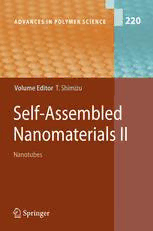
Self-Assembled Nanomaterials II: Nanotubes PDF
Preview Self-Assembled Nanomaterials II: Nanotubes
220 Advances in Polymer Science EditorialBoard: A.Abe·A.-C.Albertsson·R.Duncan·K.Duˇsek·W.H.deJeu H.-H.Kausch·S.Kobayashi·K.-S.Lee·L.Leibler·T.E.Long I.Manners·M.Möller·O.Nuyken·E.M.Terentjev B.Voit·G.Wegner·U.Wiesner AdvancesinPolymerScience RecentlyPublishedandForthcoming Volumes Self-AssembledNanomaterialsII ChromatographyforSustainable Nanotubes PolymericMaterials VolumeEditor:Shimizu,T. Renewable,DegradableandRecyclable Vol.220,2008 VolumeEditors:Albertsson,A.-C., Hakkarainen,M. Self-AssembledNanomaterialsI Vol.211,2008 Nanofibers VolumeEditor:Shimizu,T. WaxCrystalControl·Nanocomposites Vol.219,2008 Stimuli-ResponsivePolymers Vol.210,2008 InterfacialProcessesandMolecularAggregation ofSurfactants FunctionalMaterialsandBiomaterials VolumeEditor:Narayanan,R. Vol.209,2007 Vol.218,2008 Phase-SeparatedInterpenetratingPolymer Networks NewFrontiersinPolymerSynthesis Authors:Lipatov,Y.S.,Alekseeva,T. VolumeEditor:Kobayashi,S. Vol.208,2007 Vol.217,2008 HydrogenBondedPolymers PolymersforFuelCellsII VolumeEditor:Binder,W. VolumeEditor:Scherer,G.G. Vol.207,2007 Vol.216,2008 Oligomers·PolymerComposites PolymersforFuelCellsI MolecularImprinting VolumeEditor:Scherer,G.G. Vol.206,2007 Vol.215,2008 PhotoresponsivePolymersII PolysaccharidesII VolumeEditors:Marder,S.R.,Lee,K.-S. VolumeEditor:Klemm,D. Vol.214,2008 Vol.205,2006 NeodymiumBasedZieglerCatalysts– PhotoresponsivePolymersI FundamentalChemistry VolumeEditors:Marder,S.R.,Lee,K.-S. VolumeEditor:Nuyken,O. Vol.213,2008 Vol.204,2006 Polyfluorenes PolymersforRegenerativeMedicine VolumeEditors:Scherf,U.,Neher,D. VolumeEditor:Werner,C. Vol.212,2008 Vol.203,2006 Self-Assembled Nanomaterials II Nanotubes Volume Editor: ToshimiShimizu Withcontributionsby T.Aida·T.Fukushima·G.Liu·M.Numata S.Shinkai·M.Steinhart·T.Yamamoto 123 TheseriesAdvancesinPolymerSciencepresentscriticalreviewsofthepresentandfuturetrendsin polymerandbiopolymerscienceincludingchemistry,physicalchemistry,physicsandmaterialscience. Itisadressedtoallscientistsatuniversitiesandinindustrywhowishtokeepabreastofadvancesin thetopicscovered. Asarule,contributionsarespeciallycommissioned.Theeditorsandpublisherswill,however,always bepleasedtoreceivesuggestionsandsupplementaryinformation.PapersareacceptedforAdvancesin PolymerScienceinEnglish. InreferencesAdvancesinPolymerScienceisabbreviatedAdvPolymSciandiscitedasajournal. SpringerWWWhomepage:springer.com VisittheAPScontentatspringerlink.com ISBN978-3-540-85104-2 e-ISBN978-3-540-85105-9 DOI10.1007/978-3-540-85105-9 AdvancesinPolymerScienceISSN0065-3195 LibraryofCongressControlNumber:2008933504 (cid:1)c 2008Springer-VerlagBerlinHeidelberg Thisworkissubjecttocopyright.Allrightsarereserved,whetherthewholeorpartofthematerial isconcerned,specificallytherightsoftranslation,reprinting,reuseofillustrations,recitation,broad- casting,reproductiononmicrofilmorinanyotherway,andstorageindatabanks.Duplicationof thispublicationorpartsthereofispermittedonlyundertheprovisionsoftheGermanCopyrightLaw ofSeptember9,1965,initscurrentversion,andpermissionforusemustalwaysbeobtainedfrom Springer.ViolationsareliabletoprosecutionundertheGermanCopyrightLaw. Theuseofgeneraldescriptivenames,registerednames,trademarks,etc.inthispublicationdoesnot imply, even in the absence of a specific statement, thatsuchnamesareexempt fromthe relevant protectivelawsandregulationsandthereforefreeforgeneraluse. Coverdesign:WMXDesignGmbH,Heidelberg TypesettingandProduction:le-texpublishingservicesoHG,Leipzig Printedonacid-freepaper 9876543210 springer.com VolumeEditor Prof.Dr.ToshimiShimizu NanoarchitectonicsResearchCenter(NARC) NationalInst.ofAdvancedIndustrialScienceandTechnology(AIST) 1-1-1Higashi,Tsukuba Ibaraki305-8565,Japan [email protected] EditorialBoard Prof.AkihiroAbe Prof.Dr.WimH.deJeu DepartmentofIndustrialChemistry PolymerScienceandEngineering TokyoInstituteofPolytechnics UniversityofMassachusetts 1583Iiyama,Atsugi-shi243-02,Japan 120GovernorsDrive [email protected] AmherstMA01003,USA [email protected] Prof.A.-C.Albertsson Prof.Hans-HenningKausch DepartmentofPolymerTechnology TheRoyalInstituteofTechnology EcolePolytechniqueFédéraledeLausanne 10044Stockholm,Sweden SciencedeBase [email protected] Station6 1015Lausanne,Switzerland Prof.RuthDuncan [email protected] WelshSchoolofPharmacy Prof.ShiroKobayashi CardiffUniversity RedwoodBuilding R&DCenterforBio-basedMaterials KingEdwardVIIAvenue KyotoInstituteofTechnology CardiffCF103XF,UK Matsugasaki,Sakyo-ku [email protected] Kyoto606-8585,Japan [email protected] Prof.KarelDuˇsek Prof.Kwang-SupLee InstituteofMacromolecularChemistry, Czech DepartmentofAdvancedMaterials AcademyofSciencesoftheCzechRepublic HannamUniversity HeyrovskýSq.2 561-6Jeonmin-Dong 16206Prague6,CzechRepublic Yuseong-Gu305-811 [email protected] Daejeon,SouthKorea [email protected] VI EditorialBoard Prof.L.Leibler Prof.OskarNuyken MatièreMolleetChimie LehrstuhlfürMakromolekulareStoffe EcoleSupérieuredePhysique TUMünchen etChimieIndustrielles(ESPCI) Lichtenbergstr.4 10rueVauquelin 85747Garching,Germany 75231ParisCedex05,France [email protected] [email protected] Prof.E.M.Terentjev Prof.TimothyE.Long CavendishLaboratory DepartmentofChemistry MadingleyRoad andResearchInstitute CambridgeCB3OHE,UK VirginiaTech [email protected] 2110HahnHall(0344) Blacksburg,VA24061,USA Prof.BrigitteVoit [email protected] InstitutfürPolymerforschungDresden HoheStraße6 Prof.IanManners 01069Dresden,Germany SchoolofChemistry [email protected] UniversityofBristol Cantock’sClose Prof.GerhardWegner BS81TSBristol,UK Max-Planck-Institut [email protected] fürPolymerforschung Ackermannweg10 Prof.MartinMöller 55128Mainz,Germany DeutschesWollforschungsinstitut [email protected] anderRWTHAachene.V. Pauwelsstraße8 Prof.UlrichWiesner 52056Aachen,Germany MaterialsScience&Engineering [email protected] CornellUniversity 329BardHall Ithaca,NY14853,USA [email protected] AdvancesinPolymerScience AlsoAvailableElectronically ForallcustomerswhohaveastandingordertoAdvancesinPolymerScience, weoffertheelectronicversionviaSpringerLinkfreeofcharge.Pleasecontact yourlibrarianwhocanreceiveapasswordorfreeaccesstothefullarticlesby registeringat: springerlink.com Ifyoudonothaveasubscription,youcanstillviewthetablesofcontentsofthe volumesandtheabstractofeacharticlebygoingtotheSpringerLinkHome- page,clickingon“BrowsebyOnlineLibraries”,then“ChemicalSciences”,and finallychooseAdvancesinPolymerScience. Youwillfindinformationaboutthe – EditorialBoard – AimsandScope – InstructionsforAuthors – SampleContribution atspringer.comusingthesearchfunction. Color figures are published in full color within the electronic version on SpringerLink. Preface Nanotechnology is the creation of useful materials, devices, and systems through the control of matter on the nanometer-length scale. This takes placeatthescaleofatoms,molecules, andsupramolecular structures.Inthe worldofchemistry,therationaldesignofmolecularstructuresandoptimized control of self-assembly conditions have enabled us to control the resultant self-assembled morphologies having 1 to 100-nm dimensions with single- nanometer precision. This current research trend applying the bottom-up approachtomolecules remarkably contrastswiththe top-downapproachin nanotechnology,inwhichelectronicdevicesareminiaturizingtosmallerthan 30nm.However,evenengineersworkingwithstate-of-the-artcomputertech- nologystatethat maintaining therateofimprovement based onMoore’slaw willbethemostdifficultchallengeinthenextdecade. On the other hand, the excellent properties and intelligent functions of avarietyofnaturalmaterialshaveinspired polymerandorganicchemiststo tailortheirsyntheticorganicalternativesbyextractingtheessentialstructural elements. In particular, one-dimensional structures in nature with sophisti- catedhierarchy,suchasmyelinatedaxonsinneurons,tendon,proteintubesof tubulin,andspiderwebs,provideintriguingexamplesofintegratedfunctions andproperties. Againstthisbackground,supramolecularself-assemblyofone-dimensional architectures like fibers and tubes from amphiphilic molecules, bio-related molecules,andproperlydesignedself-assemblingpolymermoleculeshasat- tractedrapidlygrowinginterest.Theintrinsicpropertiesoforganicmolecules suchasthediversityofstructures,facileimplementationoffunctionality,and theaggregationproperty,provideinfinitepossibilitiesforthedevelopmentof newandinteresting advanced materials inthenear future. Themorphologi- callyvariable characteristicsofsupramolecular assemblies canalso function as pre-organized templates to synthesize one-dimensional hybrid nanocom- posites. The obtained one-dimensional organic–inorganic, organic–bio, or organic–metal hybrid materials are potentially applicable to sensor/actuator arrays,nanowires,andopto-electricdevices. ThepresentvolumesonSelf-AssembledNanofibers(Volume219)andNano- tubes(Volume220)provideanoverviewonthoseaspectswithineightchapters. Differentpointsofviewarereflected,featuringinterestingaspectsrelatedto(a) X Preface theself-assembly ofsupramolecular nanofibers comprising oforganic, poly- meric,inorganicandbiomolecules(N.Kimizuka,inVolume219,Chapter1), (b) controlled self-assembly of artificial peptides and peptidomimetics into nanofiber architectures (N. Higashi, T. Koga, in Volume 219, Chapter 2), (c) self-assemblednanostructuresfromamphiphilicrodmolecules(B.-K.Cho,H.- J.Kim,Y.-W.Chung,B.-I.Lee,M.Lee,inVolume219,Chapter3),(d)theproduc- tion of functional self-assembled nanofibers by electrospinning (A. Greiner, J.H. Wendorff, in Volume 219, Chapter 4), (e) the synthesis of tailored π– electronic organic nanotubes and nanocoils (T. Yamamoto, T. Fukushima, T.Aida, inVolume220, Chapter 1), (f)preparationandfundamentalaspects of nanotubes self-assembled fromblockcopolymers (G. Liu, in Volume 220, Chapter2),(g)β-1,3-glucanthatcanactasuniquenaturalnanotubesandincor- porateconjugatedpolymersormolecularassemblies(M.Numata,S.Shinkai, inVolume220,Chapter3),and(h)thefabricationofself-assembledpolymer nanotubes involving the use of a nanoporous hard template (M. Steinhart, inVolume220,Chapter 4). Avarietyofnanofibersandnanotubeswithwell- definedmorphologiesanddimensionsarediscussedintermsofself-assembly ofmolecularandpolymerbuildingblocksinbulksolutionorconfinedgeom- etrylikenanopores. Current materials and manufacturing technologies strongly require tech- nological advances for reducing environmental load combined with energy andresourcesavingsinproduction.Inordertodevelopsuchtechnologiesfor the development of a sustainable society, research on materials production basedontheself-assemblytechniqueisofgreatinterest.Hopefully,thesevol- umeswillbebeneficialtoreadersinvolvedwithself-organizationinthefield ofbottom-upnanotechnologyaswellasthoseconcernedwithindustrialfiber processing. Tsukuba,June2008 ToshimiShimizu Contents Self-AssembledNanotubesandNanocoils fromπ-ConjugatedBuildingBlocks T.Yamamoto·T.Fukushima·T.Aida . . . . . . . . . . . . . . . . . . . 1 BlockCopolymerNanotubesDerivedfromSelf-Assembly G.Liu . . . . . . . . . . . . . . . . . . . . . . . . . . . . . . . . . . . . 29 Self-AssembledPolysaccharideNanotubes Generatedfromβ-1,3-GlucanPolysaccharides M.Numata·S.Shinkai . . . . . . . . . . . . . . . . . . . . . . . . . . . 65 SupramolecularOrganizationofPolymericMaterials inNanoporousHardTemplates M.Steinhart . . . . . . . . . . . . . . . . . . . . . . . . . . . . . . . . . 123 SubjectIndex . . . . . . . . . . . . . . . . . . . . . . . . . . . . . . . . 189
